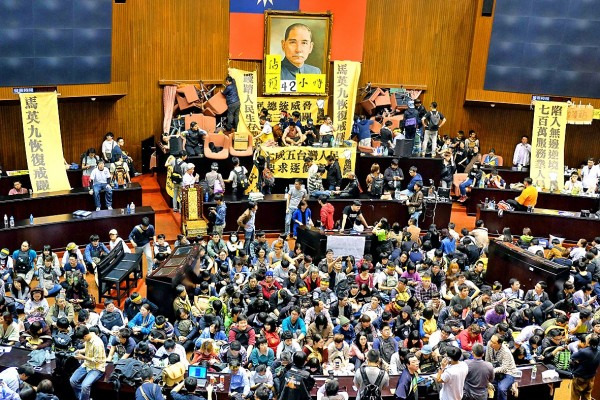《TAIPEI TIMES 焦點》 Taiwan marks movement’s first anniversary

A year after students occupied Taiwan`s parliament in an audacious protest against trade links with China, the island`s political landscape has shifted dramatically, with the ruling party routed in local polls and new caution over warming mainland ties. Photo: AFP
/ AFP, TAIPEI
A year after students occupied Taiwan’s legislature in an audacious protest against the government’s handling of trade links with China, the nation’s political landscape has shifted dramatically, with the ruling party routed in local polls late last year and new caution over warming ties with China.
About 200 students and activists broke through security lines and seized the main legislative chamber on March 18 last year, in what became known as the Sunflower movement, with thousands of supporters rallying on the streets of the capital Taipei.
The demonstrations were sparked by a service sector trade pact with China that protesters said had been secretly settled.
Their anger reflected wider discontent over ties with China, which have improved under the administration of President Ma Ying-jeou (馬英九), who came to power in 2008. While the thaw has led to trade agreements and a tourist boom, some feel ordinary people have seen little benefit and there are growing fears over Beijing’s influence.
By bringing those anxieties to the fore, the movement had a dramatic impact.
“The fast-paced exchanges between the two sides [China and Taiwan] in the past seven years have slowed and halted amid concerns over Taiwan’s security, manifested by the movement,” National Chengchi University political analyst Tung Chen-yuan (童振源) said.
“The Sunflower movement was a turning point in the development of cross-strait ties,” he added.
It also encouraged people to express their wider frustrations with the Chinese Nationalist Party (KMT), National Taiwan University professor of political science Wang Yeh-lih (王業立) said.
“The KMT was concerned about issues such as the service trade pact and internationalization, but the people cared about their pockets and housing prices... public discontent that had been accumulating was set off,” he said.
The Beijing-friendly KMT suffered its worst-ever local election defeat in November last year — a vote seen as a key barometer for next year’s presidential race.
It has since been careful to couch its approach to relations with China.
“The movement dealt a big blow to the KMT... It triggered a domino effect against the government” over controversial policies, KMT Legislator Wu Yu-sheng (吳育昇) said.
Politicians now pay “more attention to the opinions of netizens, young people and civil groups in making policies. It is good for democracy”, he said.
The traditionally China-skeptic Democratic Progressive Party (DPP) gained from the election result, but is keen not to be seen as complacent in the face of an empowered electorate.
“Public sentiments are against the KMT, but there are risks, as well as opportunities, for us,” in next year’s polls, DPP spokesperson Cheng Yun-peng (鄭運鵬) said.
The DPP now has to tread a line between cross-strait trade, which could benefit Taiwan, and voters’ wishes.
As the effects of the movement continue to echo through politics, protest leaders say they could never have predicted its impact.
“None of us had expected that we could actually seize the parliament,” activist leader Lin Fei-fan (林飛帆) said. “We felt strongly that the service trade pact could hurt Taiwan’s economy and impact our democracy. We decided to take the matter into our own hands.”
Protesters adopted the sunflower, saying it was symbolic of their wish to shine a light on the trade deal and their hopes of a bright future.
The 23-day occupation ended on April 10 after Legislative Speaker Wang Jin-pyng (王金平) promised not to review the service trade pact until a law to monitor such agreements with China was introduced, a key demand of the protesters.
Taiwan has signed 21 trade and other deals with China under Ma.
“We think the Ma government is leaning too close to Beijing. We don’t oppose trade exchanges, but Taiwan should not rely too much on China and put all its eggs in one basket,” said activist Lai Pin-yu (賴品妤), spokeswoman for the Black Island National Youth Front, one of the groups behind the movement.
Campaigners say it is important to keep up the pressure. Rallies are planned to mark the anniversary of the occupation and renew calls for the passing of the oversight bill on cross-strait agreements.
“The Sunflower movement demonstrated the power of the people who were willing to stand up and support us,” Lin said. “The movement is ongoing and we are pushing for more reforms.”
Lai hopes that young people will now turn their attention to next year when Ma must step down after serving two terms.
“I think young people are no longer indifferent to politics, and so many of them came out to vote in the November elections which affected the outcome. I think their votes will have some impact in 2016,” she said.
新聞來源:TAIPEI TIMES



















